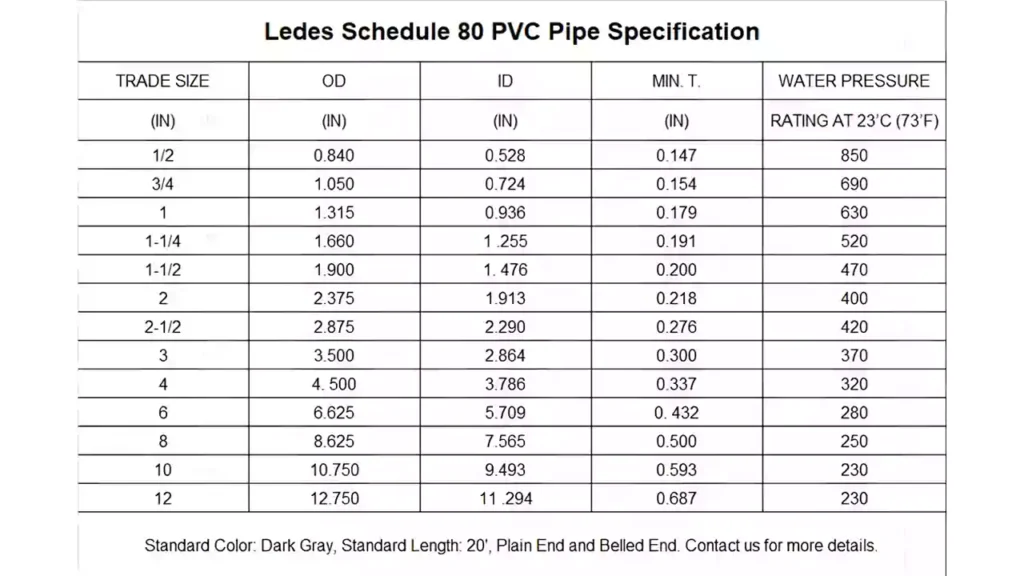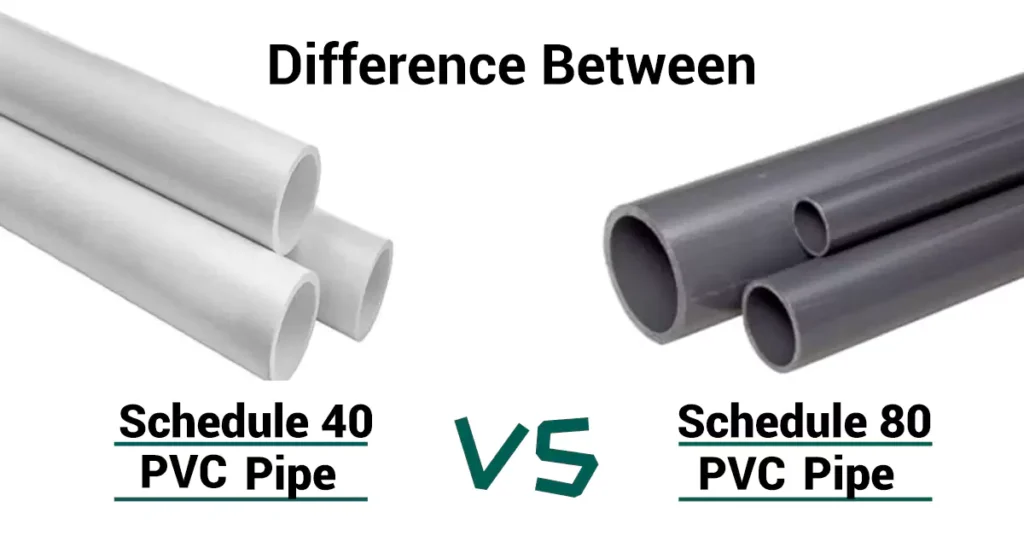
Índice
Quer estejamos reformando nossas casas, instalando sistemas de água ou elétricos, ou trabalhando como engenheiros elétricos ou encanadores, frequentemente nos deparamos com tubos de PVC ou conduítes de PVC. Esses componentes versáteis desempenham um papel crucial em vários projetos de construção. No entanto, realmente entendemos os significados e diferenças entre diferentes especificações, como tubos de PVC Schedule 40 e tubos de PVC Schedule 80? E qual é melhor?
Neste artigo, vamos nos aprofundar em uma discussão detalhada sobre as diferenças entre os tubos de PVC Schedule 40 e Schedule 80, bem como suas vantagens e desvantagens.
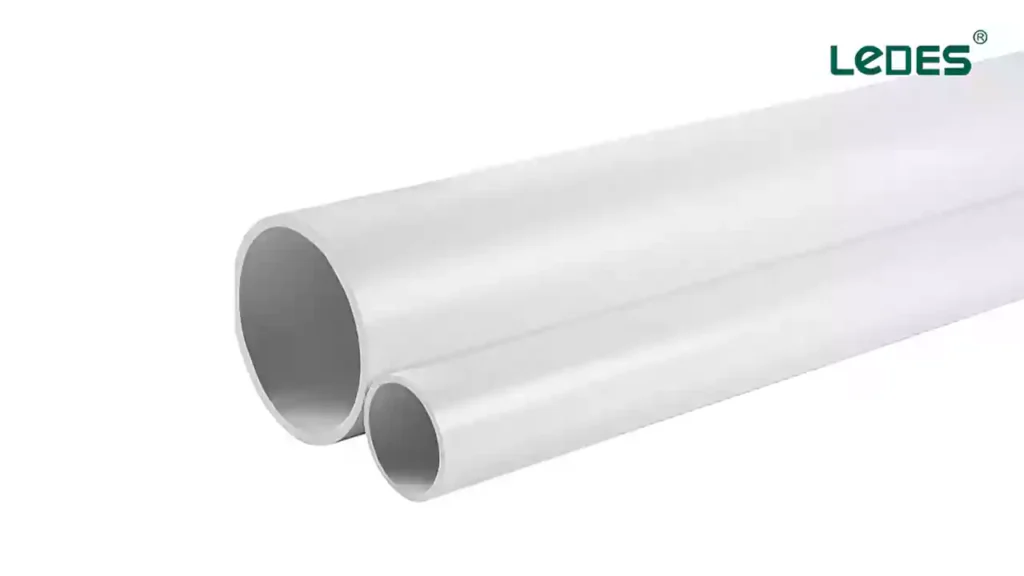
O tubo de PVC Schedule 40 geralmente é branco e usado para aplicação de água. De acordo com os padrões norte-americanos, Os tubos de PVC são identificados pelo seu tamanho nominal (NPS), que se refere ao diâmetro do tubo, e pelo número da Tabela, denotado como “Sched.” ou “Sch.”
O tubo de PVC Schedule 40 é um tipo de tubo de PVC amplamente usado com características específicas que o tornam adequado para várias aplicações. Para entender sua importância, vamos nos aprofundar em sua definição e principais características.
O número do Schedule para tubos de PVC representa a espessura da parede e determina a classificação de pressão do tubo. No caso do tubo de PVC Schedule 40, ele tem uma espessura de parede média em comparação com outros schedule.
O tubo de PVC Schedule 80 tem paredes mais grossas do que o tubo de PVC Schedule 40, que geralmente é cinza e usado para aplicações de água, como irrigação ou fins de DWV.
A principal diferença está na espessura da parede do tubo em comparação ao PVC Schedule 40. O tubo de PVC Schedule 80 tem uma parede mais espessa em comparação ao Schedule 40, permitindo que ele suporte classificações de pressão de água mais altas de até 850 PSI. No entanto, devido à sua parede mais espessa, o tubo de PVC Schedule 80 é geralmente mais caro e menos comumente usado em comparação ao tubo de PVC Schedule 40.
Conforme mencionado anteriormente, a principal diferença entre tubos de PVC Schedule 40 e Schedule 80 (incluindo conduítes de PVC) está na espessura da parede. Aqui estão algumas diferenças importantes entre eles.
- Anexo 40: Espessura de parede mais fina
- Anexo 80: Espessura de parede mais espessa, proporcionando maior resistência e durabilidade
Como sabemos, a espessura da parede está diretamente relacionada à pressão da água que o cano pode suportar. Paredes mais espessas fornecem maior resistência e durabilidade. Nesta comparação, o tubo de PVC Schedule 80 tem uma parede mais espessa e, portanto, oferece vantagens distintas sobre o tubo de PVC Schedule 40. É mais durável e duradouro.
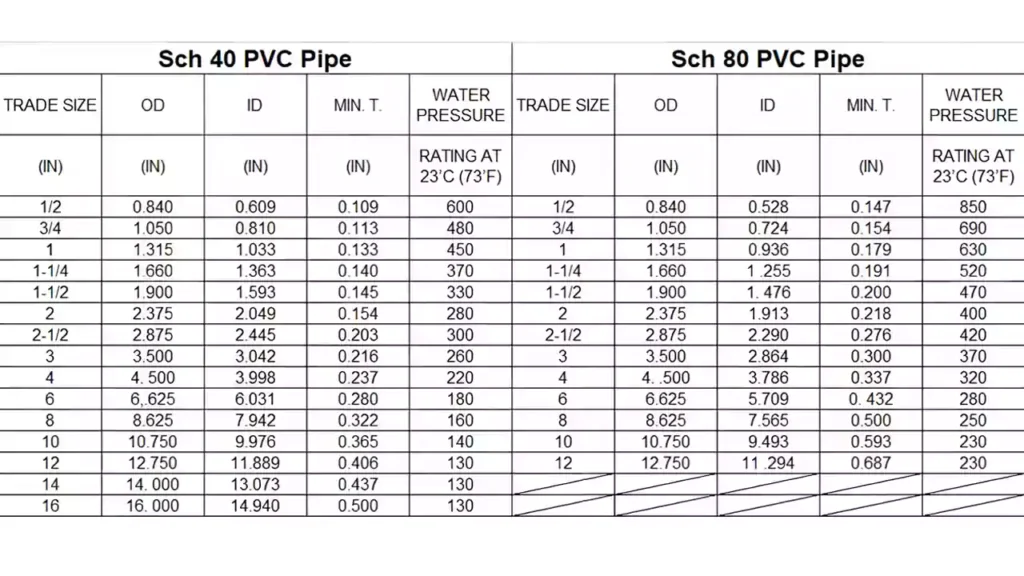
Espessura da parede de PVC do Anexo 40 vs. Anexo 80
- O Anexo 80 é geralmente mais caro devido à maior espessura da parede e aos requisitos de material
Conforme declarado no primeiro ponto, o tubo de PVC Schedule 80 tem uma parede mais espessa do que o tubo de PVC Schedule 40, o que leva a custos de fabricação mais altos. A espessura de parede aumentada requer mais matérias-primas para a produção, resultando em custos mais altos para os fabricantes. Isso, por sua vez, se traduz em preços mais altos para atacadistas e consumidores de tubos de PVC.
Devido à parede mais espessa por unidade de volume, o tubo de PVC Schedule 80 é mais pesado do que o tubo de PVC Schedule 40 do mesmo tamanho e comprimento. Embora isso possa não ser uma preocupação significativa para consumidores comuns, pode impactar distribuidores ou fabricantes que precisam pagar custos de envio mais altos para transportar os produtos de fábricas ou depósitos para os consumidores. Isso indiretamente aumenta os custos gerais.
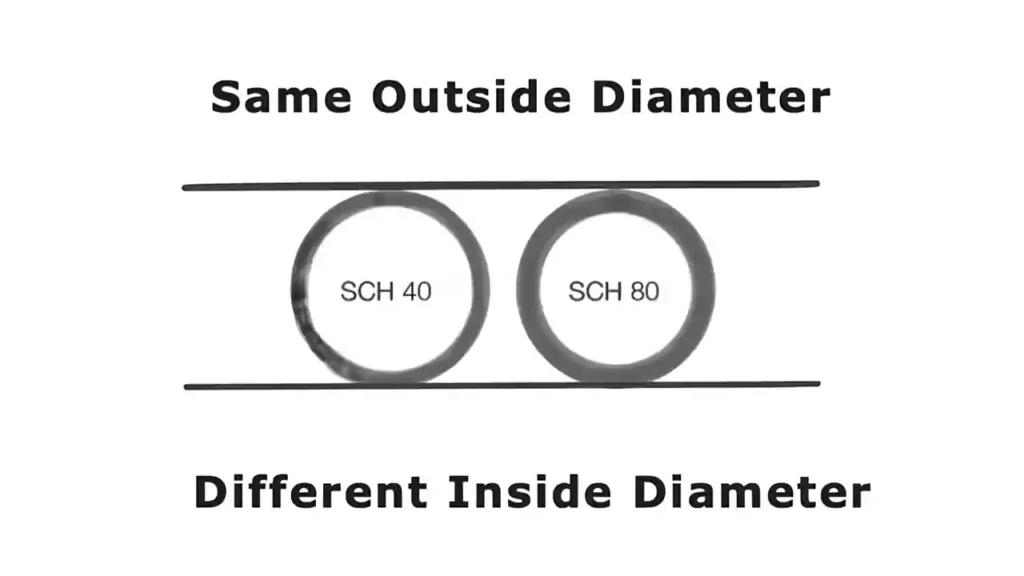
- Tanto o tubo de PVC Schedule 40 quanto o Schedule 80 têm o mesmo diâmetro externo, permitindo que eles usem os mesmos acessórios para conexões
Conforme mencionado anteriormente, as dimensões do diâmetro externo (OD) dos tubos de PVC Schedule 40 e Schedule 80 são idênticas. No entanto, devido à diferença na espessura da parede, o diâmetro interno (ID) também varia. Em resumo, devido à espessura aumentada da parede, o ID do tubo de PVC Schedule 80 é menor do que o do tubo de PVC Schedule 40. Essa diferença pode ser vista claramente no diagrama de comparação fornecido.
Devido ao seu peso mais pesado, o tubo de PVC Schedule 80 pode exigir equipamentos e pessoal diferentes para projetos de construção em larga escala em comparação ao tubo de PVC Schedule 40. Por exemplo, caminhões de transporte ou equipamentos de elevação podem precisar acomodar o peso aumentado. Além disso, tanto o tubo de PVC Schedule 40 quanto o Schedule 80, tendo o mesmo diâmetro externo, podem usar os mesmos encaixes para instalação, conforme as diretrizes ASTM e NEC. É importante usar cola de PVC especializada para fixar as conexões de todos os encaixes e tubos de PVC durante a instalação.
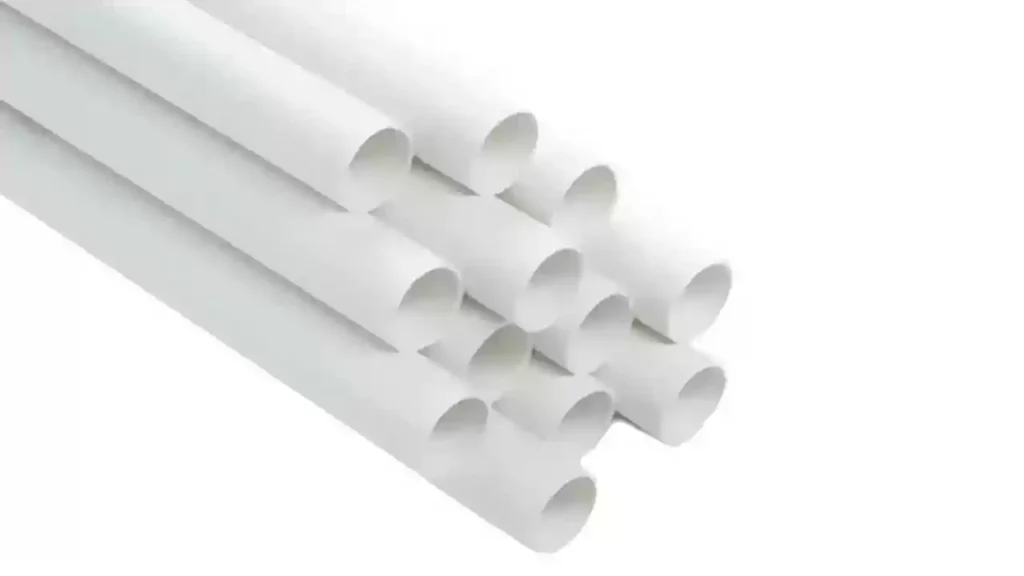
Para diferenciar entre tubos de PVC Schedule 40 e Schedule 80, eles são normalmente fabricados em cores diferentes. O tubo de PVC Schedule 40 é comumente branco, enquanto o tubo de PVC Schedule 80 é geralmente cinza escuro. Essa distinção de cores ajuda na identificação visual e facilita a instalação e a construção.
- Anexo 40: Ampla aplicabilidade, espessura de parede mais fina, peso mais leve, preço mais baixo, diâmetro interno maior e mais opções de tamanho
- Anexo 80: ampla aplicabilidade, espessura de parede mais espessa, peso mais pesado, diâmetro interno menor, menos opções de tamanho e maior classificação de pressão de água
Ao comparar tubos de PVC Schedule 40 com tubos de PVC Schedule 80, é importante considerar suas respectivas vantagens e desvantagens:
Anexo 40 PVC:
Ampla aplicabilidade, adequado para a maioria dos projetos de construção e engenharia
Espessura de parede mais fina em comparação com o PVC Schedule 80
Mais leve, menor preço e menores custos de transporte
Espessura de parede mais fina resulta em um diâmetro interno maior
Pode suportar pressão de água de até 600 PSI
Mais opções de tamanho disponíveis
Geralmente de cor branca, mas nem sempre
Anexo 80 PVC:
Ampla aplicabilidade, adequado para projetos com requisitos mais elevados
Espessura de parede mais espessa em comparação com o PVC Schedule 40
Maior peso, resultando em preços e custos de transporte mais altos
Uma espessura de parede mais espessa resulta em um diâmetro interno menor
Pode suportar pressão de água de até 850 PSI
Menos opções de tamanho disponíveis
Geralmente de cor cinza escuro, mas nem sempre
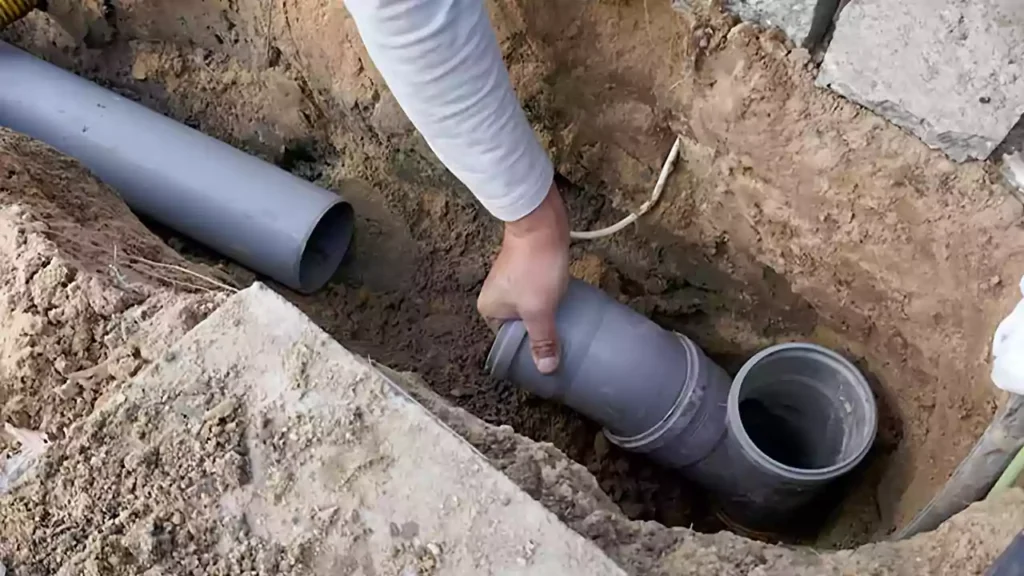
Então, para propósitos gerais de DWV (drenagem, água e ventilação), usar tubos de PVC Schedule 40 é mais econômico. No entanto, se seu projeto tiver requisitos mais altos, usar tubos de PVC Schedule 80 seria melhor.
Com base no National Código Elétrico (NEC) 352O eletroduto de PVC Schedule 40 é aprovado para diversas aplicações. Estas incluem
(A) instalações ocultas,
(B) ambientes com influências corrosivas,
(C) áreas com cinzas,
(D) locais úmidos,
(E) locais secos e úmidos,
(F) instalações expostas,
(G) instalações subterrâneas,
(H) corpos de conduíte de suporte,
(I) cumprir com as limitações de temperatura de isolamento.
Em alguns casos, também pode ser permitido para instalações acima do solo. No entanto, é importante observar que, se o conduíte não for projetado especificamente para suportar a exposição direta à luz solar, o uso prolongado em aplicações externas pode resultar em problemas como rachaduras ou danos.
Por outro lado, o Schedule 40 PVC Pipe é mais comumente usado para sistemas de drenagem, água e ventilação (DWV). Devido às diferenças em suas aplicações pretendidas, há variações nos processos de fabricação entre o Schedule 40 PVC Electrical Conduit e o Schedule 40 PVC Pipe. Por exemplo, o tubo de PVC é projetado principalmente para lidar com a pressão do fluido, então sua resistência à pressão do fluxo de água se torna um indicador importante da qualidade do produto. Em contraste, o Schedule 40 Electrical Conduit é focado principalmente na proteção da fiação interna, tornando a resistência ao impacto um fator crucial na avaliação de sua qualidade.
Apesar de suas diferenças, tanto o Schedule 40 PVC Electrical Conduit quanto o Schedule 40 PVC Pipe compartilham algumas vantagens comuns. Ambos oferecem resistência à corrosão química, não enferrujam e têm excelente durabilidade. Essas características são inerentes ao seu material de PVC.
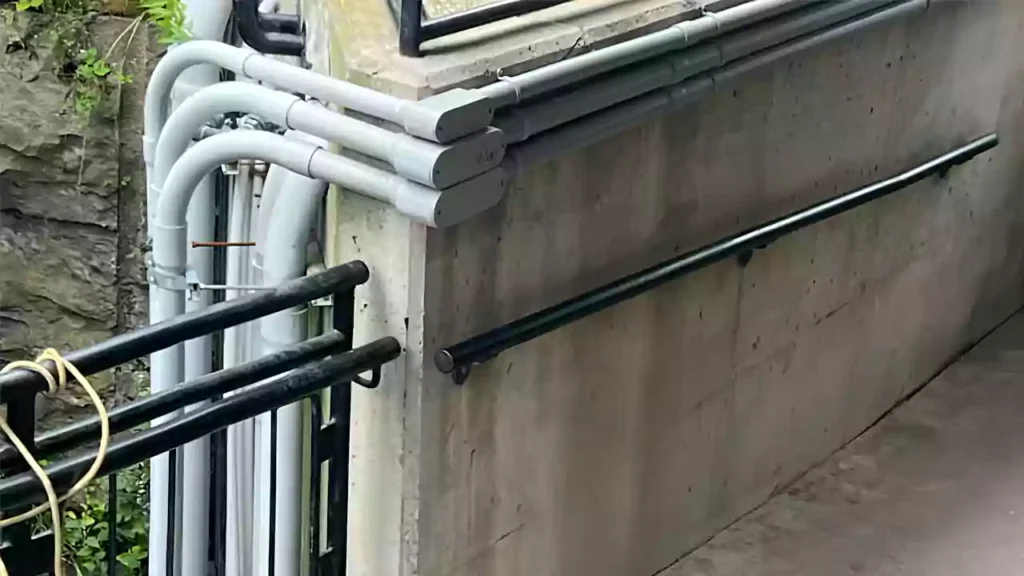
O tubo de PVC Schedule 40 é mais comumente usado para transporte de água, gás e fluidos em encanamento e irrigação. O PVC Schedule 40 é geralmente branco e tem paredes mais finas
Conduíte de PVC Schedule 40 abriga com segurança sistemas elétricos para energia e telecomunicações, atendendo aos padrões NEC 352 para aplicações acima do solo, enterradas diretamente e revestidas de concreto.
Tubos de PVC Schedule 40 e conduítes elétricos de PVC Schedule 40 são amplamente usados em vários campos e indústrias devido à sua versatilidade e confiabilidade. Algumas das aplicações comuns onde tubos de PVC Schedule 40 são frequentemente utilizados incluem:
- Sistemas elétricos e hidráulicos residenciais: O tubo de PVC Schedule 40 é comumente usado para instalações de fiação e encanamento em edifícios residenciais, fornecendo um conduíte seguro e durável para fiação elétrica e transporte de água.
- Sistemas de gerenciamento elétrico e hidráulico de edifícios comerciais: Em edifícios comerciais, como escritórios, espaços de varejo e instalações industriais, o tubo de PVC Schedule 40 é usado para gerenciar fiação elétrica e sistemas de encanamento, garantindo operações eficientes e confiáveis.
- Irrigação paisagística: O tubo de PVC Schedule 40 é popularmente empregado em sistemas de irrigação de paisagens para transportar água para jardins, gramados e outras áreas externas.
- Irrigação agrícola: Agricultores e empresas agrícolas contam com tubos de PVC do Anexo 40 para fins de irrigação, garantindo a distribuição adequada de água para plantações e campos.
- Piscinas e centros de spa: O tubo de PVC Schedule 40 é comumente usado na construção e manutenção de piscinas e centros de spa, facilitando a circulação de água e os sistemas de filtragem.
- Laboratórios: O tubo de PVC Schedule 40 é utilizado em ambientes laboratoriais para vários propósitos, como transporte de produtos químicos, sistemas de ventilação e gerenciamento de fluidos.
- Serviços de água potável: Devido à sua resistência à corrosão e à lixiviação química, o tubo de PVC Schedule 40 é frequentemente usado para transportar água potável, garantindo o fornecimento de água limpa e segura em ambientes residenciais e comerciais.
- Sistemas hidrônicos: O tubo de PVC Schedule 40 é empregado em sistemas hidrônicos de aquecimento e resfriamento, facilitando a circulação de água quente ou fria para regular a temperatura interna.
- Sistemas de abastecimento de água: Os sistemas municipais de abastecimento de água geralmente usam tubos de PVC Schedule 40 para redes de distribuição de água, fornecendo abastecimento de água confiável e eficiente às comunidades.
De acordo com os padrões ASTM 1785 e ASTM 2665, o tubo de PVC Schedule 40 está disponível em tamanhos comerciais que variam de 1/2 polegada a 16 polegadas. A classificação de pressão da água pode variar de 130 a 600 PSI, dependendo das dimensões específicas do tubo. O tubo de PVC Schedule 40 é comumente encontrado na cor branca, embora também possa estar disponível em outras cores para aplicações específicas.
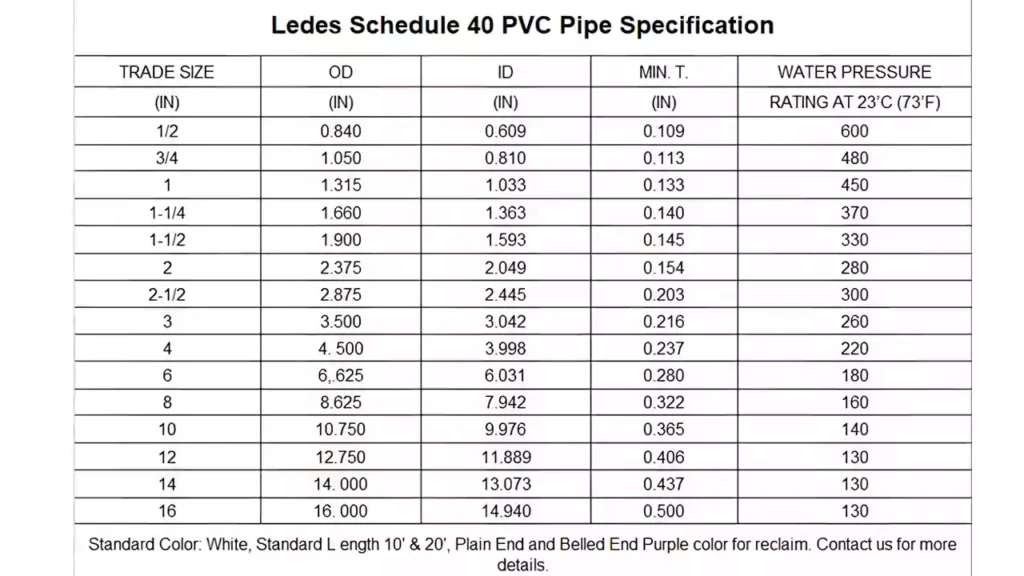
Semelhante ao tubo de PVC do Anexo 40, Conduíte de PVC Schedule 80 O tubo oferece as mesmas vantagens associadas aos tubos de plástico. Ele exibe resistência à corrosão química, não enferruja e tem alta durabilidade. Essas características o tornam adequado para uma ampla gama de aplicações.
O tubo de PVC Schedule 80, com paredes mais finas do que o tubo de PVC Schedule 40, é feito sob medida para aplicações industriais exigentes, como processamento químico, aquicultura e tratamento de água, exigindo que a tubulação suporte altas pressões e condições adversas.
O tubo de conduíte de PVC Schedule 80 encontra aplicações em vários campos, incluindo:
- Sistemas elétricos e hidráulicos residenciais: O tubo de PVC Schedule 80 é comumente usado em edifícios residenciais para sistemas de conduítes elétricos. Ele fornece um conduíte durável e resistente à corrosão para roteamento seguro de fios elétricos por toda a casa. Além disso, ele pode ser usado para aplicações de encanamento onde classificações de pressão de água mais altas são necessárias, como linhas principais de abastecimento de água ou sistemas de irrigação.
- Sistemas de gerenciamento elétrico e hidráulico de edifícios comerciais: Em edifícios comerciais, como escritórios, shopping centers e hospitais, o tubo de PVC Schedule 80 é utilizado para sistemas de conduítes elétricos para proteger e rotear a fiação elétrica. Ele também é empregado para aplicações de encanamento que exigem classificações de pressão mais altas, garantindo fornecimento de água e drenagem confiáveis por todo o edifício.
- Irrigação paisagística: O tubo de PVC Schedule 80 é adequado para sistemas de irrigação de paisagens, particularmente em áreas com maiores requisitos de pressão de água. Ele pode transportar água de forma eficiente para jardins, gramados e outros espaços externos, garantindo irrigação e manutenção adequadas das plantas.
- Irrigação agrícola: Em ambientes agrícolas, o tubo de PVC Schedule 80 é comumente usado para fins de irrigação. Ele pode lidar com pressão de água mais alta, tornando-o adequado para sistemas de irrigação de larga escala em fazendas e campos.
- Piscinas e centros de spa: O tubo de PVC Schedule 80 é ideal para construir e manter piscinas e spas. Ele pode suportar maior pressão de água e fornecer circulação e filtragem de água confiáveis, garantindo o funcionamento adequado dessas instalações recreativas.
- Laboratórios: O tubo de PVC Schedule 80 é frequentemente utilizado em ambientes de laboratório para vários propósitos. Ele pode ser usado para transportar produtos químicos, gases ou fluidos, bem como para sistemas de ventilação ou gerenciamento de resíduos.
- Serviços de água potável: O tubo de PVC Schedule 80 pode ser usado para fornecer água potável em ambientes residenciais, comerciais ou industriais. Sua resistência à corrosão e durabilidade o tornam adequado para garantir o fornecimento de água limpa e segura.
- Sistemas hidrônicos: O tubo de PVC Schedule 80 é comumente empregado em sistemas de aquecimento e resfriamento hidrônicos, onde classificações de pressão mais altas são necessárias. Ele circula eficientemente água quente ou fria, ajudando a controlar as temperaturas internas.
- Sistemas de abastecimento de água: Os sistemas de abastecimento de água municipais podem utilizar tubos de PVC Schedule 80 em áreas onde se espera maior pressão de água ou em tubos de maior diâmetro para distribuição eficiente de água.
- Projetos de construção comercial e industrial com maiores exigências: O tubo de PVC Schedule 80 é frequentemente usado em projetos comerciais e industriais que exigem classificações de pressão mais altas ou onde a aplicação demanda maior durabilidade e resistência. Isso pode incluir plantas de processamento químico, instalações de fabricação ou ambientes industriais onde o tubo precisa suportar condições mais exigentes.
Em termos de tamanho e características, o tubo de PVC Schedule 80 está disponível em tamanhos que variam de 1/2 polegada a 12 polegadas. Uma distinção importante do tubo Schedule 40 é que o tubo Schedule 80 é tipicamente cinza escuro, o que torna mais fácil diferenciar entre os dois tipos.
É importante notar que as dimensões do diâmetro externo (OD) dos tubos de PVC Schedule 40 e Schedule 80 são idênticas. A principal diferença está na espessura da parede do tubo, que afeta as dimensões do diâmetro interno (ID).
- Tubos de PVC Schedule 80 e 120: disponíveis para edifícios comerciais mais exigentes ou aplicações específicas
- Tubo CPVC: Oferece melhor desempenho, maior resistência e durabilidade aprimorada em comparação ao tubo de PVC
Sim, além dos Schedules 40 e 80, há também o tubo de PVC Schedule 120. Comparado ao tubo Schedule 80, o tubo Schedule 120 tem uma espessura de parede ainda mais espessa e é adequado para edifícios comerciais mais exigentes ou aplicações específicas, como plantas químicas ou projetos de drenagem costeira.
Além disso, há tubos CPVC disponíveis como alternativa. O CPVC oferece melhor desempenho, maior resistência e durabilidade melhorada em comparação com tubos de PVC.
Como fabricante, produzimos uma gama de produtos de tubos de PVC usando materiais de alta qualidade e as mais recentes técnicas de fabricação. Nossa linha de produtos inclui conduítes e conexões certificados pela UL e CSA, e atualizamos continuamente nossas ofertas com base nos requisitos do cliente. Se você precisar dos últimos preços de distribuidor ou atacado, sinta-se à vontade para entrar em contato conosco. Como nosso distribuidor, você também se beneficiará de serviços e suporte adicionais.
Com base nas informações fornecidas acima, agora você deve ter um melhor entendimento das diferenças entre os tubos de PVC Schedule 40 e Schedule 80. Dependendo de seus requisitos específicos e necessidades do projeto, você pode tomar uma decisão informada sobre qual produto escolher. Se precisar de mais informações sobre nossos produtos ou o setor, sinta-se à vontade para entrar em contato conosco enviando um formulário de contato ou um e-mail. Nosso objetivo é responder à sua consulta em um dia útil.
O PVC Anexo 40 é seguro para água potável?
Embora o PVC Anexo 40 tenha sido aprovado para aplicações de água potável, o cobre é geralmente considerado mais seguro para distribuição de água potável e encanamento a longo prazo.
O PVC não é recomendado para transportar água quente, pois certos produtos químicos podem potencialmente vazar do material conforme as temperaturas aumentam. Para distribuição de água fria abaixo de 80°F, o PVC Schedule 40 apresenta riscos mínimos à saúde quando devidamente unido e instalado de acordo com o código.
A Food and Drug Administration classifica o PVC rígido (tipos I e II) como aceitável para uso na fabricação de peças de artigos que entram em contato com alimentos. No entanto, água muito quente ou fervida pode causar maior extração de certos plastificantes de ftalato do PVC ao longo do tempo.
Alternativas como o CPVC (cloreto de polivinila clorado) oferecem melhor resistência à água quente em comparação ao PVC padrão, o que o torna uma opção melhor quando há temperaturas de água mais altas envolvidas.
Para sistemas de drenagem, resíduos e ventilação (DWV), o Schedule 40 PVC é completamente adequado e não apresenta preocupações, pois não entra em contato direto com consumíveis. Mas para água fria potável, muitos códigos de construção e encanadores preferem cobre ou CPVC devido à sua durabilidade superior com exposição prolongada à água quente.
Quanto tempo o tubo de PVC Schedule 40 dura no sol?
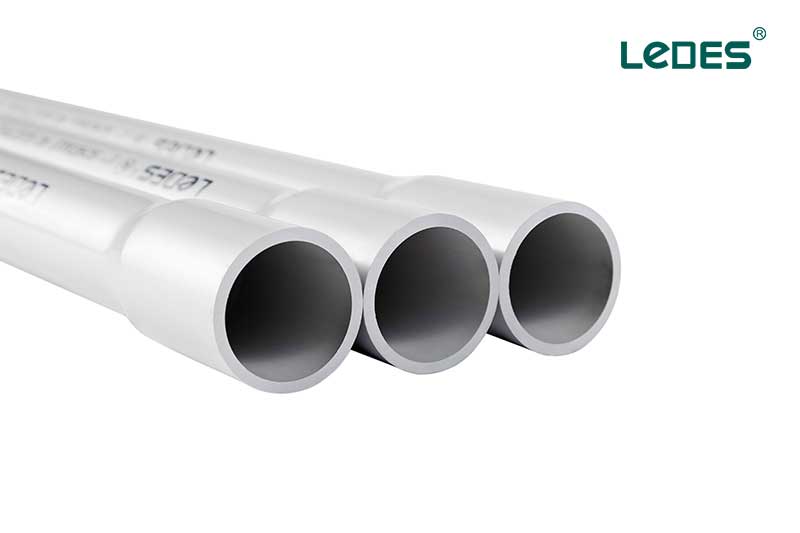
Embora o PVC teoricamente tenha uma vida útil de até 100 anos com uso normal, a exposição ao ar livre pode reduzir significativamente sua longevidade. Quando exposto ao sol direto:
- A degradação UV da luz solar faz com que o PVC se torne quebradiço e rache com o tempo. Cores mais escuras como cinza ou preto fornecem mais proteção UV do que o branco.
- O PVC Schedule 40 é classificado para aplicações subterrâneas/enterrantes, mas não para exposição solar de longo prazo acima do solo. Rachaduras/falhas podem ocorrer dentro de 5 a 10 anos sem inibidores de UV.
- Fatores como flutuações de temperatura, níveis de ozônio e poluentes atmosféricos podem acelerar os danos UV. Regiões do sul tendem a ver reduções de vida útil de 30-50%.
- Adicionar estabilizadores UV 2-3% ao PVC durante a fabricação estende sua vida útil quando exposto ao sol. Isso ajuda a evitar grandes rachaduras por 15-25 anos.
- Cobrir canos de PVC expostos com um envoltório/capa protetora resistente a raios UV os protege dos raios diretos e aumenta consideravelmente a longevidade.
Para maximizar a vida útil de mais de 50 anos ao irrigar ou usar PVC acima do solo que é exposto à luz solar, é melhor usar canos classificados para uso externo contendo inibidores de UV ou fornecer cobertura total com um envoltório bloqueador de UV. A seleção e proteção adequadas do material são essenciais.
Um cano de PVC pode ser usado como conduíte elétrico?
Não, um cano de PVC padrão não pode ser usado para conduíte elétrico. Embora ambos sejam feitos de PVC, canos de PVC e conduítes elétricos têm prioridades de design diferentes:
- Tubos de PVC são projetados e classificados para suportar pressões internas de fluido/água durante aplicações de encanamento. A tolerância à pressão é a principal consideração.
- O conduíte elétrico deve fornecer proteção e isolamento robustos para fiação fechada de acordo com os padrões de código. Sua formulação e espessura são otimizadas para resistência mecânica, resistência a impacto/perfuração.
- As paredes do conduíte são mais espessas do que a tubulação básica para evitar rachaduras/quebras que podem danificar a fiação. Às vezes, é incluído reforço adicional.
- As classificações de incêndio são críticas para conduítes, pois os códigos exigem que eles contenham incêndios e permitam evacuação segura. A tubulação não enfrenta as mesmas demandas de aquecimento.
- Os processos de fabricação também diferem para atender às especificações exclusivas de conduítes quanto à resistência ao esmagamento, capacidade de tração, conexões e facilidade de instalação ao redor de obstruções.
Embora o PVC seja uma escolha eficaz não condutiva/não corrosiva para ambos os usos, apenas conduítes listados especificamente para aplicações elétricas devem passar a fiação. Usar tubulação de PVC padrão corre o risco de comprometer o isolamento e a segurança dos fios ao longo do tempo contra tensões mecânicas. A seleção adequada de componentes garante a integridade do sistema elétrico.
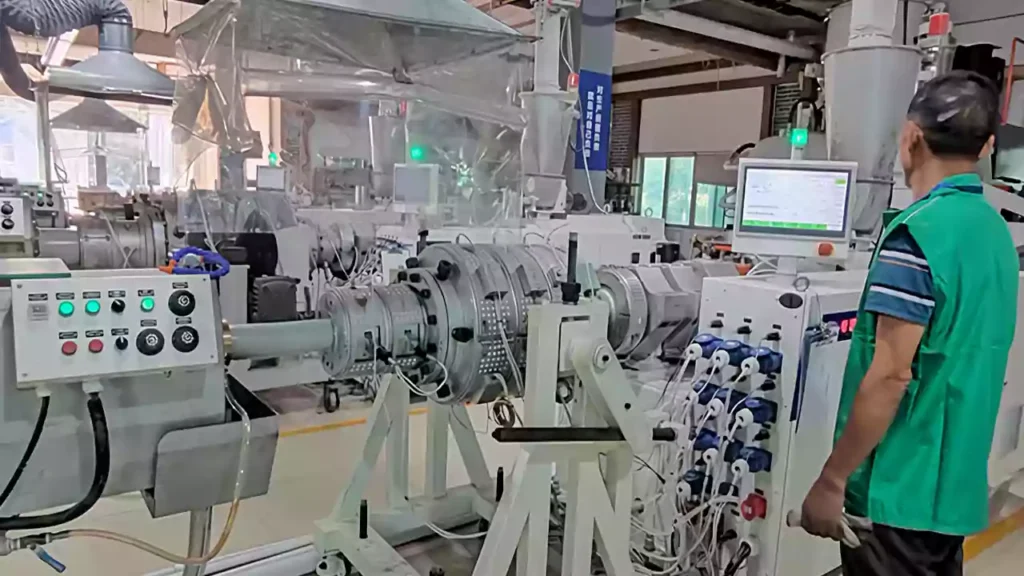
A LEDES é uma fabricante e atacadista confiável de tubos plásticos elétricos e de água. Com anos de comprometimento com a qualidade e inovação dos produtos, a LEDES se tornou a primeira fabricante certificada pela UL e CSA na China.
A LEDES atende a uma gama diversificada de aplicações, incluindo produtos de conduítes e conexões elétricas para aplicações residenciais, comerciais e industriais. E tem sido um fornecedor essencial para muitos grandes projetos de construção, incluindo o projeto CHPE nos EUA, o projeto Melbourne Tunnel, o projeto PV2 em Abu Dhabi e o projeto fotovoltaico de 2,6 GW na Arábia Saudita. Esses são projetos bem conhecidos que demonstram as capacidades da Ledes em fornecer soluções de conduítes para empreendimentos de construção complexos e de grande escala. O histórico da empresa demonstra sua capacidade de atender aos requisitos exigentes de tais projetos e fornecer soluções confiáveis e eficientes.
A LEDES fornece um conjunto completo de produtos elétricos para sistemas elétricos, incluindo:
- Produtos listados pela UL padrão americano – Conduítes e conexões de PVC rígido Schedule 40 e 80, ENT.
- Produtos certificados pela norma canadense CSA – conduíte rígido de PVC, duto de comunicação DB2, tubos não metálicos, etc.
- Normas australianas e neozelandesas – Conduítes, tubos e conexões para serviços pesados e médios.
- Produtos padrão britânico;
- Conduítes e acessórios com baixo teor de fumaça e sem halogênio;
- Conduítes e acessórios elétricos solares fotovoltaicos resistentes a UV.
Os produtos são certificados pela UL, CSA, AS/NZS, CE, IEC e outros certificados. Garantir a conformidade com os rigorosos padrões da indústria e atender às necessidades de diversas aplicações.
É isso. Se você ainda tiver alguma dúvida, você pode envie-nos um e-mail agora.


